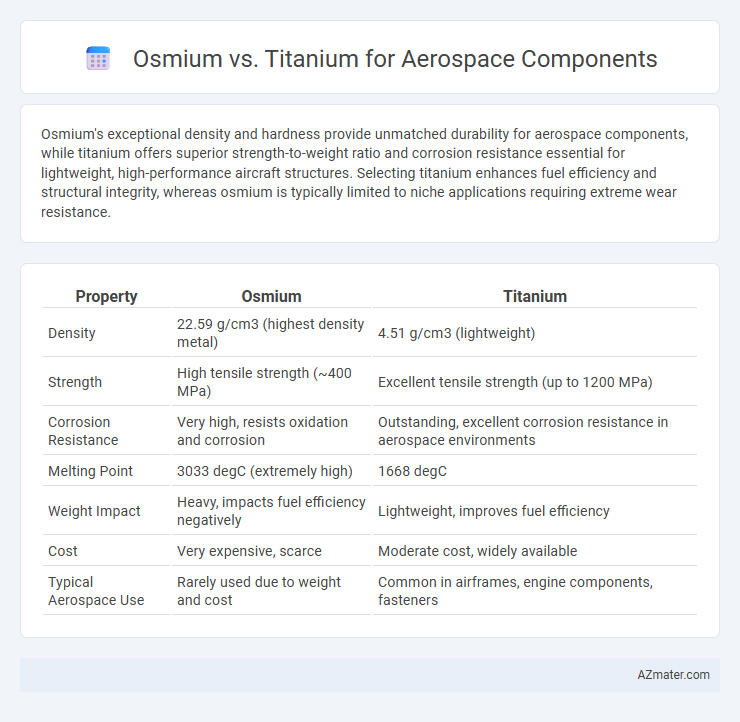Osmium's exceptional density and hardness provide unmatched durability for aerospace components, while titanium offers superior strength-to-weight ratio and corrosion resistance essential for lightweight, high-performance aircraft structures. Selecting titanium enhances fuel efficiency and structural integrity, whereas osmium is typically limited to niche applications requiring extreme wear resistance.
Table of Comparison
| Property | Osmium | Titanium |
|---|---|---|
| Density | 22.59 g/cm3 (highest density metal) | 4.51 g/cm3 (lightweight) |
| Strength | High tensile strength (~400 MPa) | Excellent tensile strength (up to 1200 MPa) |
| Corrosion Resistance | Very high, resists oxidation and corrosion | Outstanding, excellent corrosion resistance in aerospace environments |
| Melting Point | 3033 degC (extremely high) | 1668 degC |
| Weight Impact | Heavy, impacts fuel efficiency negatively | Lightweight, improves fuel efficiency |
| Cost | Very expensive, scarce | Moderate cost, widely available |
| Typical Aerospace Use | Rarely used due to weight and cost | Common in airframes, engine components, fasteners |
Overview of Osmium and Titanium in Aerospace Applications
Osmium, one of the densest metals known, offers exceptional hardness and corrosion resistance but is rarely used in aerospace due to its brittleness and high cost. Titanium, favored for aerospace components, provides an optimal balance of high strength-to-weight ratio, corrosion resistance, and temperature tolerance, making it ideal for airframes, engine parts, and structural elements. Aerospace applications prioritize titanium over osmium because titanium's lightweight properties significantly enhance fuel efficiency and performance in both commercial and military aircraft.
Material Properties Comparison: Osmium vs Titanium
Osmium exhibits exceptional density and hardness with a density of 22.59 g/cm3 and a melting point of 3033degC, making it one of the densest and hardest metals, but it is brittle and difficult to machine. Titanium, with a density of 4.51 g/cm3 and a melting point of 1668degC, offers superior strength-to-weight ratio, corrosion resistance, and excellent ductility, which is crucial for aerospace components subjected to dynamic stresses. The lower density and higher fracture toughness of titanium make it the preferred material over osmium for aerospace applications where weight savings and mechanical resilience are critical.
Strength and Weight Considerations
Osmium offers exceptional density and hardness, making it one of the strongest metals by weight, but its extreme heaviness limits its practicality in aerospace applications where weight reduction is critical. Titanium provides an optimal balance of high tensile strength and low density, enhancing fuel efficiency and structural integrity in aerospace components. The superior strength-to-weight ratio of titanium makes it the preferred material in aircraft and spacecraft design over osmium, despite osmium's higher absolute strength.
Corrosion Resistance and Durability
Osmium exhibits exceptional corrosion resistance due to its dense atomic structure, making it highly resistant to oxidation and chemical degradation in extreme aerospace environments. Titanium, while also corrosion-resistant, particularly against saltwater and acidic conditions, offers superior durability with a high strength-to-weight ratio essential for aerospace components subjected to cyclic stress and temperature variations. Comparing both, osmium's corrosion resistance outperforms titanium's, but titanium remains the preferred choice for aerospace durability and structural applications due to its lighter weight and proven fatigue resistance.
Cost and Availability of Osmium and Titanium
Titanium is widely favored in aerospace for its high strength-to-weight ratio, corrosion resistance, and relative abundance, which ensures moderate material costs and steady availability. Osmium, while extremely dense and hard, is scarce and significantly more expensive due to limited natural reserves and complex extraction processes, making it less practical for large-scale aerospace applications. The cost-effectiveness and supply stability of titanium outweigh osmium's unique properties in aerospace component manufacturing.
Machinability and Fabrication Challenges
Osmium's extreme hardness and brittleness create significant challenges in machining, requiring specialized tools and techniques that increase production complexity and cost. Titanium offers superior machinability with better tool life and less wear, making it more practical for intricate aerospace component fabrication. Fabrication of osmium demands controlled environments to prevent oxidation and contamination, whereas titanium's well-established processing methods simplify manufacturing and scalability.
Thermal and Electrical Conductivity Differences
Osmium exhibits significantly lower thermal conductivity than titanium, with osmium averaging around 87 W/m*K compared to titanium's 21.9 W/m*K, making titanium preferable for aerospace components requiring efficient heat dissipation. In terms of electrical conductivity, osmium's performance is markedly better, approximately 1.0 MS/m, whereas titanium has a much lower conductivity near 0.6 MS/m, which influences material selection where electrical performance is critical. The disparity in thermal and electrical conductivities impacts component design choices in aerospace engineering, balancing heat management and electrical integration needs.
Safety and Toxicity Concerns
Osmium's extreme density and hardness make it a candidate for specialized aerospace components but its significant toxicity, particularly osmium tetroxide fumes, poses serious safety risks during manufacturing and handling. Titanium offers high strength-to-weight ratio, corrosion resistance, and biocompatibility, making it a safer and more practical choice for aerospace applications with minimal toxicological hazards. Rigorous handling protocols are essential for osmium to mitigate toxicity, whereas titanium's inert nature reduces occupational exposure and environmental concerns.
Real-World Aerospace Case Studies
Osmium and titanium exhibit distinct advantages in aerospace component applications, with titanium favored for its high strength-to-weight ratio and corrosion resistance in airframes and engine parts, as demonstrated in the Boeing 787 Dreamliner's airframe construction. Osmium's exceptional density and hardness have led to experimental use in high-wear, precision instruments within aerospace, such as gyroscope components in satellite navigation systems, though its rarity and brittleness limit widespread adoption. Case studies highlight titanium's versatility and cost-effectiveness in structural elements, while osmium remains a niche material for specialized applications requiring extreme durability.
Future Prospects and Innovations in Aerospace Materials
Osmium's exceptional density and hardness present unique opportunities for radiation shielding and high-wear components in aerospace, although its weight limits widespread structural use compared to titanium's superior strength-to-weight ratio and corrosion resistance. Innovations in composite materials incorporating titanium alloys are advancing lightweight, high-strength aerospace components with improved fuel efficiency and durability. Future prospects include combining the unique properties of osmium with titanium in nanostructured coatings or hybrid materials to enhance performance under extreme aerospace conditions.

Infographic: Osmium vs Titanium for Aerospace Component
 azmater.com
azmater.com